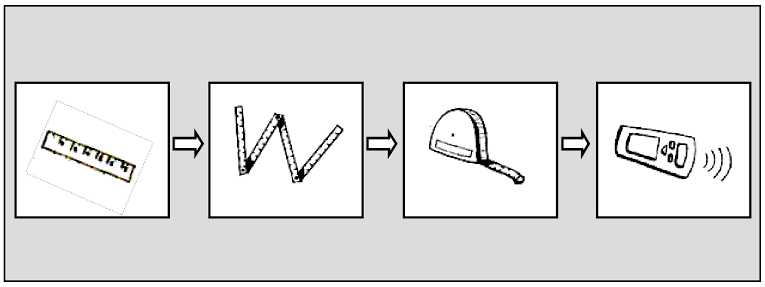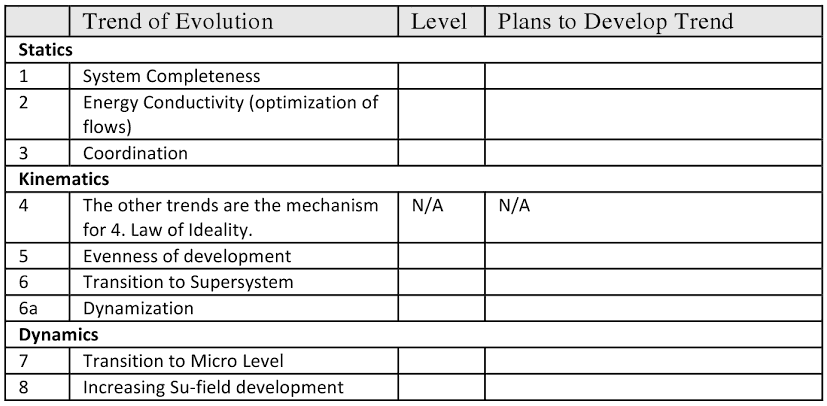IDEALITY AND SYSTEM EVOLUTION
OVERVIEW
During their evolution, systems progress both by making basic incremental improvements (Level 1 type solutions) and by overcoming contradictions (Level 2 and higher solutions). Knowing the system trends can help you to find the most suitable methods to advance a system closer to its most ideal state.
IDEALITY
The Trend of Increasing Ideality states that over time, technical systems develop towards increased ideality.
Ideality (the value of the system) will increase if functionality increases. Ideality will also increase if the cost and harmful effects (expense) decreases.
Ideality is summarized by the following equation:

Cost is defined not only in monetary cost but, the use of any resources or materials, the number of components used, and the amount of space and time used. Harmful effects may be any negative effect associated with the system. For example, a lawnmower cuts grass but it may also be very noisy, which can be considered as a harmful effect. We can think of cost plus harmful effects as the expense we pay for a functionality.
The ideal system is one for which functionality is infinite and the cost payment factors are zero.
The ideal solution occurs when a system solves a problem by itself, for free. For example, my bicycle tire frequently gets punctures. The solution is to find a way to make a self sealing tire or one that cannot puncture.
8 TYPES OF SYSTEM EVOLUTION
Listed below are the original eight trends created in the 1970s plus the trend of dynamization which was added in the 1980s:
1. The Trend of Increasing Completeness of a System – A simple system will evolve to a more highly developed one by accumulating four basic “functional blocks.” It starts life with the operating part then adds another three parts usually in the following sequence: transmission, energy source, and control system.
a. TRIZ Workshop – Pg. 125
2. Trend of Energy Conductivity – In order for a system to operate, it needs to provide some energy to flow through all parts of the system. A system will not operate unless all parts work. The energy flow includes flow of information, substances, materials, objects, etc. A system will evolve to increase useful flows of energy and reduce harmful flows. A light bulb won’t operate without the unhindered flow of electrical energy. A digital watch will not function unless it is driven by the flow of electrical power. A motor car requires energy to flow from the engine through the wheels in order to move. A freeway system won’t operate when there is a blockage on the road.
3. Trend of Increasing Coordination or Trend of Harmonization Systems – A system will evolve to be more coordinated. For example, a driver’s seat in a car developed to fit the shape of the driver.
4. Trend of Ideality – was discussed above. All trends are driven by a trend towards becoming more ideal.
5. Trend of Uneven Development of System Components – The development of a system’s parts typically grows unevenly – the more complex the system, the greater the number of irregularities.
6. Trend of Transition to the Supersystem – Over time, technical systems merge with the supersystem. As the system reaches its own limits of development in order to become more ideal, it merges with systems from outside, incorporating external elements or external components.
7. Trend of Dynamization – As a system develops it will trend towards an increase in the ability to change parameters in time (i.e, shape, temperature, size, etc. will fluctuate and adapt). It will become more dynamic and gain more freedom of movement.
8. Trend of Transition to Micro Level – The operating part or “tool” of a system begins as a macro level component or subsystem and develops towards the micro level. The operating part is the bristles on a paintbrush, the propeller of an airplane, the blade of a saw. Instead of macro objects, the work carried out by the operating part is performed by a new part or subsystem that operates at the micro level, which is at the level of particles, atoms, molecules, electrons, and particle fields.
9. Trend of Increasing Su-field Development – The evolution of technical systems will proceed in the direction of increasing Su-field development. The trend of increasing Su-field development is that incomplete, ineffective or harmful Su-fields strive to become effective complete Su-fields and that effective complete Su-fields will develop by increasing the dispersion of substances (the number and types of “things” will grow), the number of links between the elements will grow (more interactions by forming complex, double and chain Su-fields) and the responsiveness of the system will grow (the ability of the system to be controlled). Systems will also trend to more evolved field types. Mechanical fields evolve to acoustic to thermal to chemical and finally to electric and magnetic fields (sometimes the mnemonic MATCHEM is used to help remember this sequence).
A CLOSER LOOK AT THE TRENDS
The Trend of Dynamization
Solid systems and materials become more flexible; they will become more dynamic and gain more freedom of movement. Solid systems of components evolve to include a single joint, then multiple joints. For example, a ruler was originally solid then evolved to have one joint then many joints to become a folding ruler. Then it became flexible tape measure, and eventually used a field (laser measure).

Characteristics:
- Systems may develop from being in a solid state to be in the form of powder, then liquid, then gas and finally as a type of field.
- Fields typically evolve from constant to gradient, impulse, resonance, interference.
- Freedom of movement develops from 1 dimension to 2 and then to 3 dimensions. Communication by telephone cables (2D) moved to 3D wireless.
The Trend of Uneven Development of System Components
The development of a system’s parts typically grows unevenly – the more complex the system, the more the number of non-uniform developing parts. The uneven development often leads to the creation and opportunity of identifying and solving new contradictions.
Components may be at different stages of evolution. A sailing ship could move but their navigation systems did not develop to a high level until later. Many explorers did not know where they were. A ship’s hull has developed to be large but the braking system has not evolved to effectively stop the ship. It takes several miles to stop a large oil tanker. These discrepancies can be formed into contradictions to be solved.
There was rapid development in the reduction in size of hand-held electronic devices, but slow development in the means of inputting information. The keyboard was less evolved because the physical contradiction that the keyboard must be large to allow easy input of information and small to be portable was still being solved.
The Trend of Transition to the Supersystem
Over time, systems merge with their supersystems. As the system reaches its own limits of development in order to become more ideal, it merges with external systems.
The most basic integration with the supersystem is when a single system integrates with another identical system to increase its functionality. An example is a single razor adds another to become a twin blade razor. Multiples of the same system can be integrated to increase functionality even further, for example a multi-blade razor.
As systems follow the trend of transition to the supersystem, they start to include more diverse types of system. First, they incorporate similar systems that perform a similar function—for example, a knife with different types of blade. Then differences begin to grow to include more divergent functionality—for example, a screwdriver for both flat and cross head screws.
Competing systems integrate—for example, the hybrid car has an electric fuel cell and a gas combustion engine. Systems that complement each other in the same process combinesdfds—for example, washing powder and scent fragrance. Systems that perform opposite functions combine—for example a pencil with an eraser or a hammer and nail extractor.
The number of systems that integrate increase – a Swiss army knife incorporates blades, bottle opener, nail files, screwdriver, comb, laser pointer, even a flash memory device etc. Printers have been integrated with photocopiers, fax machines, scanners, and many even have a stapler and staple extractor.
Distinctions between the system’s main function and the function of the systems integrated with the supersystem often become wider—for example, an integrated bottle opener and radio.
STEPS FOR APPLYING TRENDS OF EVOLUTION TO A GENERAL PROBLEM
- Describe the system or component that is to be developed. Note that a system may have several components each at a different level of development relative to each trend.
- On an arbitrary scale of 1-10 (1 is low and 10 is highly developed), estimate the level of development relative to each trend.
- Based on the level of development, define a plan for development of the system. The plan should focus on improving the less developed aspects of the system by bringing them to a more evolved state.
- Repeat for each component of the system.

ADVANTAGES
- Helps you determine that most effective ways to develop a system or component to its ideal state
- Provides perspectives of how an ideal version of a system or component should look and the level of development required to reach that ideal state
FURTHER READING
- Cameron, Gordon. (2010). Trizics: Teach yourself TRIZ, how to invent, innovate and solve “impossible” technical problems systematically. Retrieved November 12, 2016, from https://www.amazon.com/Trizics-yourself-impossible-technical-systematically/dp/1456319892

